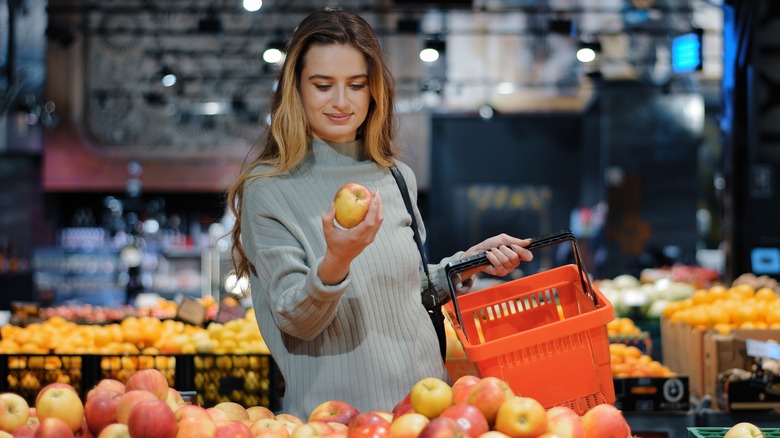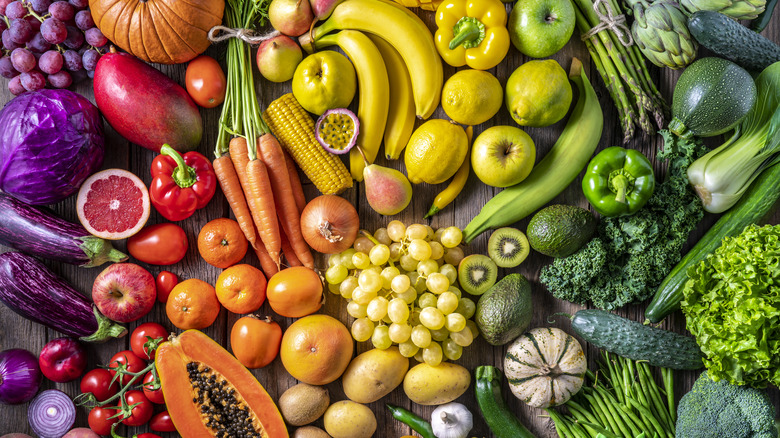Ina Garten's Etiquette Rule For Grocery Store Fruit Stands
We've all done it: You're shopping in the grocery store produce department and you start squeezing fruits or veggies to see if they're firm or soft. Though this small action seems harmless, pro chef Ina Garten warned shoppers against it in an interview with the BBC. Garten explained that every test squeeze can leave its mark, bruising the produce's flesh or even damaging its skin. This simply isn't fair to grocery store staff, or other shoppers who might pick up what you leave behind.
Once a piece of produce has been squeezed, bacteria has an easier way in, meaning the food is likely to spoil more quickly. This can turn into a loss for the unsuspecting shopper who buys it, or for the store when the damaged or spoiled produce cannot be sold and instead has to be thrown out.This is why Garten tells fellow shoppers to avoid the practice, and luckily, there are ways to judge the ripeness of a fruit or vegetable without poking and prodding it.
Instead of gauging ripeness by texture, try to take in visual and aromatic cues. For instance, a good tomato should look bright and shiny, smell sweet, and feel heavy in your hand. If a tomato meets the criteria, there's no need to give it a squeeze to test for firmness. Citrus fruits should also feel heavy for their size. Likewise, you can judge the sweetness of a watermelon by using the two-finger trick to measure the width of its stripes.
Don't peel fruit and veggies at the store, either
Just as squeezing a piece of fruit at the grocery store can damage its quality, so can peeling. The most common victim is corn, which shoppers typically husk in-store to check for color and quality. However innocent the intent, removing the husk leaves the corn vulnerable to bacteria, further damage, and potentially drying out. You wouldn't peel open a banana and leave it, would you? Stripping corn of its husk and then leaving it behind can cause food waste and profit losses for the store, and is unfair to other shoppers, as they'll now have less corn to choose from.
In much the same way, damage and waste can occur if you peel away a bit of an avocado's skin to check the flesh underneath. Flicking off the stem of an avocado to check the color beneath seems harmless, but doing so creates an entrance for bacteria and hastens decomposition. Regardless of the type of produce, you should avoid damaging the peel in any way –- if not for other shoppers, then for yourself. The CDC actually recommends against eating produce with broken skin due to the risk of foodborne illness, once again from bacterial contamination.
Buy produce locally and seasonally for the best picks
To go back to Ina Garten's advice, the Barefoot Contessa has another tip to ensure you're buying great produce — without having to squeeze it. She suggests buying fruits and veggies when they're in season, as she told Epicurious. If a given fruit is currently in season and grown locally, it's much more likely to be ripe than an out-of-season piece of fruit that has been transported and stored for several weeks (or even months).
On a similar note, when you scope out the grocery store produce department, pick the freshest groceries by reaching to the back. Stores restock from the back, meaning the oldest produce is in the front and more visible to shoppers, while the newest produce is tucked away behind. Although stores do this to make sure products are sold in the same order in which they were harvested or manufactured, you can just as easily use their strategy to your advantage. In other words, grabbing your potatoes from the back will give you a slightly longer shelf-life than if you chose a bag from the front.



